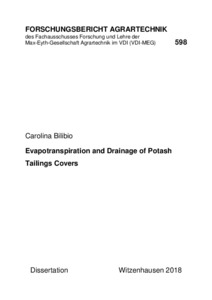| dc.date.accessioned | 2018-07-31T06:43:16Z | |
| dc.date.available | 2018-07-31T06:43:16Z | |
| dc.date.issued | 2018-07-31 | |
| dc.identifier.issn | 0931-6264 | |
| dc.identifier.uri | urn:nbn:de:hebis:34-2018073155923 | |
| dc.identifier.uri | http://hdl.handle.net/123456789/2018073155923 | |
| dc.language.iso | eng | |
| dc.rights | Urheberrechtlich geschützt | |
| dc.rights.uri | https://rightsstatements.org/page/InC/1.0/ | |
| dc.subject.ddc | 630 | |
| dc.title | Evapotranspiration and Drainage of Potash Tailings Covers | eng |
| dc.type | Dissertation | |
| dcterms.abstract | Potassium is one of the three main nutrients for crop production, along with nitrogen and phosphorus. Potassium is found in the potash ores of evaporites. Evaporites are mineral deposits of evaporated landlocked sea water from a former arid climate. The processing of potash ores produces millions of tons of solid and liquid wastes with a high concentration of sodium chloride. In Germany the liquids are in some cases pressed under the earth or disposed in surface waters. In contrast, the solids are often heaped above ground near the processing facilities or backfilled in mining voids. The tailings piles on the surface are exposed to precipitation erosion producing additional brines. Therefore, there is a need to implement methods to minimize the seepage of brines from potash tailings piles and reduce soil and water contamination. This can be achieved using evapotranspiration covers. Evapotranspiration covers consist of a soil reservoir and perennial plants to transport the moisture back to the atmosphere. With that in mind, a lysimeter experiment was conducted at the Wintershall potash processing facility from K+S KALI, in the outskirts of Heringen, Germany. Four different covers of potash tailings piles made of household waste incineration slags and coal combustion residues were studied. The substrates were used to fill-in 8 non-weighable lysimeters. A mixture of 65 % ryegrass (Lolium perenne L.), 25 % red fescue (Festuca rubra L.) and 10 % Kentucky bluegrass (Poa pratensis L.) was established on the substrates’ surface. The weather conditions were monitored using an automated weather station, four rain gauges placed at ground-level, and five rain gauges installed at 1-m height. The weather station registered the precipitation, air temperature, horizontal wind speed, relative air humidity, solar radiation and substrate temperature at 10 minute interval. The precipitation in ground level and 1-m-high gauges was assessed weekly. Weekly measurements also included the seepage amount, which was gathered in 60 liter barrels. The actual evapotranspiration was studied using the simplified water balance equation ETa = P - D, whereby P is precipitation and D is the drainage, both given in mm. The hydrological properties of the substrates were measured in order to calibrate Hydrus-1D and to simulate the water fluxes considering different rates of fine fractions, soil texture and crop parameters. Moreover, the water deficit of the potash tailings’ covers was verified using the CropWat model. From the observed measurements it was estimated a mean actual evapotranspiration over three hydrological years of 440.5 mm or 65.5 % for the actual evapotranspiration versus the ground-level precipitation ratio. Moreover, a mean seepage rate of 231.5 mm (34.5 %) was found between 2014 and 2016. It was verified no large differences among the substrates for seepage and actual evapotranspiration. Due to the optimal weather conditions for the crop growth, higher evapotranspiration was found in the summer (mean 363.1 mm; 91 %) than in winter time (mean 77.5 mm; 27.5 %). The calibrated Hydrus-1D model provided consistent seepage values with a variation of 2.9 % or circa 13.6 mm from the observed measurements of substrates 1-4 between 2014 and 2015. The calibrated model estimated an evapotranspiration rate of 75.3 % and a seepage rate of 24.7 % considering 27 years of historical weather data, which agrees with the data available in the literature. Furthermore, the simulations using Hydrus-1D suggested that an increase in fine fractions and clay-size particles may decrease the seepage of the tailings covers, as well as any change in the crop status might lead to altering the seepage and evapotranspiration values. From the CropWat study, a water deficit mainly for the spring and summer months was found. The estimated water deficit was on average 193.7 mm/year during the assessment period between 2014 and 2016. Altogether this study showed that evapotranspiration covers may decrease seepage rates of potash tailings piles. Further studies should be conducted to investigate the chemical properties of the technogenic substrates made of household waste incineration slags and coal combustion residues, as well as their specific seepage characteristics. | eng |
| dcterms.accessRights | open access | |
| dcterms.creator | Bilibio, Carolina | |
| dcterms.isPartOf | Forschungsbericht Agrartechnik des Fachausschusses Forschung und Lehre der Max-Eyth-Gesellschaft Agrartechnik im VDI (VDI-MEG) ;; 598 | ger |
| dc.contributor.corporatename | Kassel, Universität Kassel, Fachbereich Ökologische Agrarwissenschaften, Fachgebiet Agrartechnik | |
| dc.contributor.referee | Hensel, Oliver (Prof. Dr.) | |
| dc.contributor.referee | Schmeisky, Helge (Prof. Dr.) | |
| dc.subject.swd | Evaporit | ger |
| dc.subject.swd | Kalium | ger |
| dc.subject.swd | Abfall | ger |
| dc.subject.swd | Salzwasser | ger |
| dc.subject.swd | Reduktion | ger |
| dc.subject.swd | Lysimeter | ger |
| dcterms.source.series | Forschungsbericht Agrartechnik des Fachausschusses Forschung und Lehre der Max-Eyth-Gesellschaft Agrartechnik im VDI (VDI-MEG) | ger |
| dcterms.source.volume | 598 | ger |
| dc.date.examination | 2018-07-12 | |

